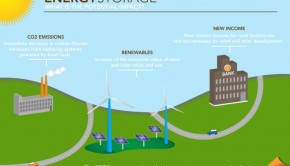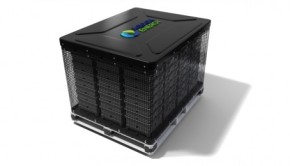Aquion Energy Reveals Second-Gen AHI Battery Technology, 40% Increase In Energy
November 13th, 2014 by James Ayre
 Aquion Energy recently revealed the second generation of its Aqueous Hybrid Ion (AHI™) battery and energy storage system technology.
Aquion Energy recently revealed the second generation of its Aqueous Hybrid Ion (AHI™) battery and energy storage system technology.
The new second generation of the AHI technology reportedly offers an increase in energy “of up to 40%” — without any increase in the size/weight of the S-Line Battery Stack or the M-Line Battery Module product lines.
“We have been hard at work making the world’s best long duration battery even better. The improved chemistry of the second generation Aqueous Hybrid Ion battery yields more energy, and will deliver more value for our customers,” stated Scott A. Pearson, CEO of Aquion Energy. “We are unveiling the new technology at Solar Power International because Aquion’s unmatched long duration batteries enable optimal self-consumption of distributed solar generation and ease the burden of intermittent renewable energy on the grid. These two applications are the key to unlocking broad adoption of clean solar electricity as a mainstream energy source.”
The new generation of the company’s product lines will see a number of different improvements, with the substantial increase in energy being accomplished through an improved utilization of the primary active material in the AHI cells.
“At shorter four to eight hour discharge rates, systems will experience an energy increase of up to 40%. At longer 20 hour discharge rates the second generation S-Line Battery Stack will see a 24% increase in energy to 2.4 kW-hours, while the new M-Line Battery Module will see a 16% increase, now totaling 25.5 kW-hours.”
Given the improved performance, the batteries are now even better suited towards use in conjunction with renewable energy systems.
Those interested can find the product specifications of Aquion’s second generation product line here.
Related:
Innovative Battery Startup Aquion Brings In $55 Million
Image Credit: Aquion
Keep up to date with all the hottest cleantech news by subscribing to our (free) cleantech newsletter, or keep an eye on sector-specific news by getting our (also free) solar energy newsletter, electric vehicle newsletter, or wind energy newsletter.
-
Vensonata
-
MarTams
-
Robert C
-
Edwardian
-
Serge
-
MarTams
-
sault
-
-
-























